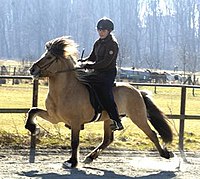
Photo from wikipedia
This investigation examined the association between slow gait speed, as defined with newly established cut-points, and all-cause mortality in older Americans with a matched cohort analysis. The analytic sample included… Click to show full abstract
This investigation examined the association between slow gait speed, as defined with newly established cut-points, and all-cause mortality in older Americans with a matched cohort analysis. The analytic sample included 10,259 Americans aged ≥65 years from the 2006–2014 waves of the Health and Retirement Study. Walking speed was measured in participant residences. Slow gait speed cut-points of <0.60 and <0.75 m/s were used separately for classifying participants as having slow walking speed. Nearest-neighbor propensity score matching was used to match the slow to the not-slow cohorts separately using both cut-points using relevant covariates. Persons with gait speed <0.60 m/s had a 1.42 higher hazard for mortality (95% CI: 1.28–1.57). Older Americans with gait speed <0.75 m/s had a 1.36 higher hazard for mortality (95% CI: 1.23–1.50). Slow gait speed may represent failing health and addressing how slow gait speed could be improved may help with referrals to appropriate interventions.
Journal Title: Journal of Applied Gerontology
Year Published: 2022
Link to full text (if available)
Share on Social Media: Sign Up to like & get
recommendations!